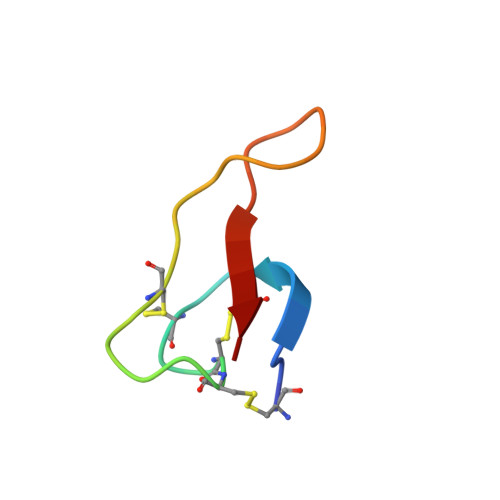Roseltide rT7 is a disulfide-rich, anionic, and cell-penetrating peptide that inhibits proteasomal degradation.
Kam, A., Loo, S., Fan, J.S., Sze, S.K., Yang, D., Tam, J.P.(2019) J Biological Chem 294: 19604-19615
- PubMed: 31727740
- DOI: https://doi.org/10.1074/jbc.RA119.010796
- Primary Citation of Related Structures:
6KLM - PubMed Abstract:
Disulfide-rich plant peptides with molecular masses of 2-6 kDa represent an expanding class of peptidyl-type natural products with diverse functions. They are structurally compact, hyperstable, and underexplored as cell-penetrating agents that inhibit intracellular functions. Here, we report the discovery of an anionic, 34-residue peptide, the disulfide-rich roseltide rT7 from Hibiscus sabdariffa (of the Malvaceae family) that penetrates cells and inhibits their proteasomal activities. Combined proteomics and NMR spectroscopy revealed that roseltide rT7 is a cystine-knotted, six-cysteine hevein-like cysteine-rich peptide. A pair-wise comparison indicated that roseltide rT7 is >100-fold more stable against protease degradation than its S -alkylated analog. Confocal microscopy studies and cell-based assays disclosed that after roseltide rT7 penetrates cells, it causes accumulation of ubiquitinated proteins, inhibits human 20S proteasomes, reduces tumor necrosis factor-induced IκBα degradation, and decreases expression levels of intercellular adhesion molecule-1. Structure-activity studies revealed that roseltide rT7 uses a canonical substrate-binding mechanism for proteasomal inhibition enabled by an IIML motif embedded in its proline-rich and exceptionally long intercysteine loop 4. Taken together, our results provide mechanistic insights into a novel disulfide-rich, anionic, and cell-penetrating peptide, representing a potential lead for further development as a proteasomal inhibitor in anti-cancer or anti-inflammatory therapies.
- School of Biological Sciences, Nanyang Technological University, Singapore 637551.
Organizational Affiliation:
















